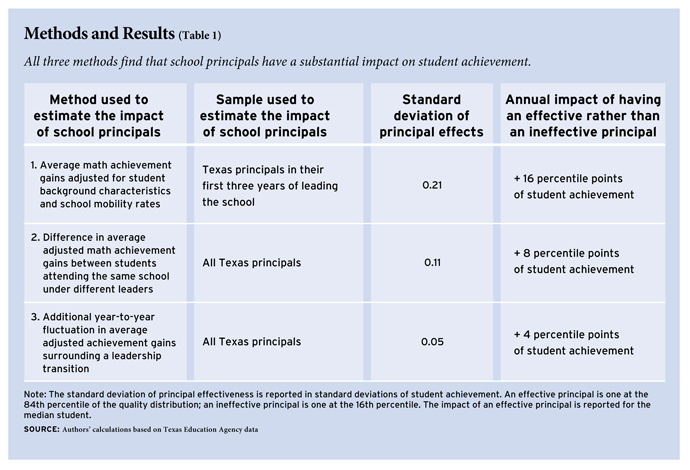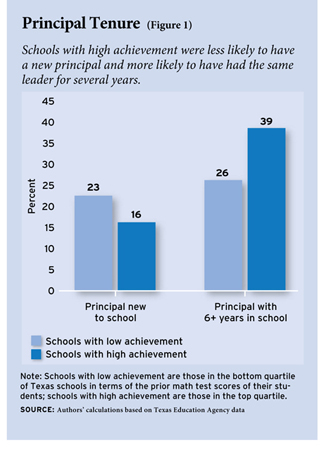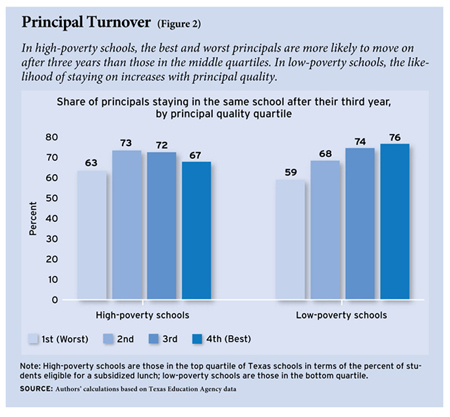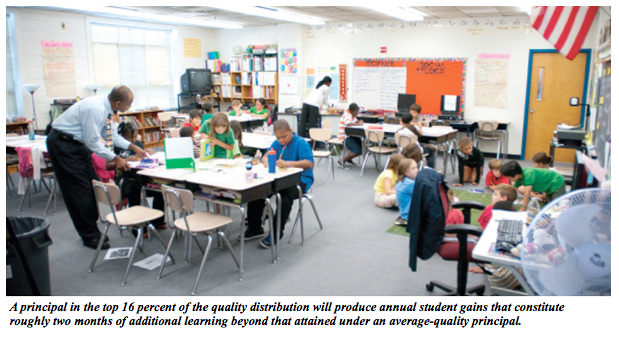
It is widely believed that a good principal is the key to a successful school. No Child Left Behind encouraged the replacement of the principal in persistently low-performing schools, and the Obama administration has made this a requirement for schools undergoing federally funded turnarounds. Foundations have invested millions over the past decade in New Leaders for New Schools, an organization that recruits nontraditional principal candidates and prepares them for the challenges of school leadership. And the recently launched George W. Bush Institute is making the principalship a focus of its activities. Yet until very recently there was little rigorous research demonstrating the importance of principal quality for student outcomes, much less the specific practices that cause some principals to be more successful than others. As is often the case in education policy discussions, we have relied on anecdotes instead.
This study provides new evidence on the importance of school leadership by estimating individual principals’ contributions to growth in student achievement. Our approach is quite similar to studies that measure teachers’ “value added” to student achievement, except that the calculation is applied to the entire school. Specifically, we measure how average gains in achievement, adjusted for individual student and school characteristics, differ across principals—both in different schools and in the same school at different points in time. From this, we are able to determine how much effectiveness varies from one principal to the next.
Our results indicate that highly effective principals raise the achievement of a typical student in their schools by between two and seven months of learning in a single school year; ineffective principals lower achievement by the same amount. These impacts are somewhat smaller than those associated with having a highly effective teacher. But teachers have a direct impact on only those students in their classroom; differences in principal quality affect all students in a given school. We also investigate one widely discussed mechanism through which principals affect student achievement: the management of teacher transitions. Importantly, because high teacher turnover can be associated with both improvement and decline in the quality of instruction, the amount of turnover on its own provides little insight into the wisdom of a principal’s personnel decisions. We confirm, however, that teachers who leave schools with the most-successful principals are much more likely to have been among the less-effective teachers in their school than teachers leaving schools run by less-successful principals. The final component of our analysis considers the dynamics of the principal labor market, comparing the effectiveness of principals who move on to those who stay in their initial schools. Constrained by salary inertia and the historical absence of good performance measures, the principal labor market does not appear to weed out those principals who are least successful in raising student achievement. This is especially true in schools serving disadvantaged students. This is troubling, as the demands of leading such schools, including the need to attract and retain high-quality teachers despite less desirable working conditions, may amplify the importance of having an effective leader.
The Texas Database
Our analysis relies on administrative data constructed as part of the University of Texas at Dallas (UTD) Texas Schools Project. Working with the Texas Education Agency (TEA), this project has combined different data sources to create matched data sets of students, teachers, and principals over many school years. The data include all Texas publicschool teachers, administrators, staff, and students in each year, permitting accurate descriptions of the schools led by each principal.
The Public Education Information Management System (PEIMS), TEA’s statewide database, reports key demographic data, including race, ethnicity, and gender for students and school personnel, as well as student eligibility for subsidized lunch (a standard indicator of poverty). PEIMS also contains detailed annual information on teacher and administrator experience, salary, education, class size, grade, population served, and subject. Importantly, this database can be merged with information on student achievement by school, grade, and year. Beginning in 1993, Texas schools have administered the Texas Assessment of Academic Skills (TAAS) each spring to eligible students in grades 3 through 8. Our analysis therefore focuses on principals in elementary and middle schools, for whom it is possible to develop performance measures.
The personnel data combine time as a teacher and as an administrator into total experience, so it is not possible to measure tenure as a principal accurately for those who became a principal prior to the initial year of our data (the 1990–91 school year). We therefore concentrate on the years from 1995 to 2001. Over this period, we are able to observe 7,420 individual principals and make use of 28,147 annual principal observations.
Measuring Principal Quality
The fundamental challenge to measuring the impact of school leaders is separating their contributions from the many other factors that drive student achievement. For example, a school that serves largely affluent families may create the illusion that it has a great principal, when family backgrounds are the key cause of high achievement. Alternatively, a school that serves disadvantaged students may appear to be doing poorly but in fact have a great principal who is producing better outcomes than any other principal would.
Our basic value-added model measures the effectiveness of a principal by examining the extent to which math achievement in a school is higher or lower than would be expected based on the characteristics of students in that school, including their achievement in the prior year. Put another way, it examines whether some schools have higher achievement than other schools that serve similar students and attributes that achievement difference to the principal. This approach is very similar to that employed in studies that measure teacher quality using databases tracking the performance of individual students over time.
The main concern with this approach is that there may be unmeasured factors that affect school performance. Our data contain only basic information on student background characteristics, such as gender, race or ethnicity, and eligibility for subsidized lunch. As a result, we cannot control for more nuanced measures of students and their families, such as motivation or wealth. We are, however, able to control for students’ test scores from the previous year, which may well capture a lot of the characteristics that we cannot measure directly. Moreover, there are also school factors not under the direct control of the school, including the quality of teachers inherited by the principal. Below we describe alternative approaches to isolating the contributions of the current principal.
In estimating principal effectiveness, we want to minimize the influence of specific circumstances and look at the underlying stable differences in impacts. This issue is important because a principal’s impact may vary with tenure in a school. A principal’s impact on the quality of the teaching staff (whether negative or positive), for example, probably increases over time as the share of teachers who were hired on her watch rises. To account for any differences in effectiveness that are related to tenure as a principal in a given school, we begin our analysis by focusing on data from the first three years a principal leads a school.
This first analysis indicates that the standard deviation of principal effectiveness is 0.21 standard deviations of test scores (see Table 1). This is a very large figure, perhaps unbelievably large, implying that a principal at the 75th percentile of this effectiveness measure shows average achievement gains of 0.11 standard deviations (relative to the average principal), while one at the 25th percentile shows average losses of 0.15 standard deviations. These differences are even more pronounced in high-poverty schools, for which the gap between the 25th and 75th percentile principal is more than one-third of a standard deviation. On average across all schools, the impact of having a principal 1 standard deviation more effective than the average principal is as much as seven additional months of learning in a single academic year.

As noted above, this initial estimate of the variability in principal effectiveness may partly reflect differences in school characteristics that are not under the principal’s control, such as the quality of the school building, or decisions made by district administrators as well as unmeasured parental influences. As a result, it may overestimate the amount of influence principals actually have.
We begin to address this issue by measuring principal effectiveness based only on comparisons of within-school differences in student achievement growth over time. In simplest terms, we compare average student achievement gains in the same school under different principals. This method eliminates the influence of any student, school, or neighborhood characteristics that do not change over time. Its main drawback is that it ignores all differences in principal effectiveness between schools, potentially underestimating the amount of variation in principal quality. For example, if each school tends to attract principals who are similar in quality whenever it searches for a new principal, this approach will understate the true extent of variation in principal effectiveness.
We conduct this second analysis using all of the principals in our data, not just those in their first three years leading a school, because the numbers of schools with two principals observed in their first three years is quite small. (Note that re-doing the prior analysis using data on all principals does not significantly alter the results presented above.) Restricting the analysis to comparisons within schools, however, cuts our estimate of the variation in principal effectiveness in half. Even this reduced estimate is substantial, however, indicating that a 1-standard-deviation increase in principal effectiveness raises school average achievement by slightly more than 0.10 standard deviations. This impact is roughly comparable to that observed for variations in teacher effectiveness in studies that use the same kinds of within-school comparisons.
Our first two methods involved estimating effectiveness measures for individual principals and then calculating the standard deviation of those measures. Although any unmeasured school factors that are unrelated to principal quality would not bias these results, such factors would inflate our estimates of the variation in principal quality based on these approaches. We therefore employ a third approach that gauges the amount of variation in principal effectiveness directly by measuring the additional fluctuation in school average achievement gains when a new principal assumes leadership, as compared to typical fluctuations from year to year.
Focusing on the additional variation in school average achievement gains around principal transitions reduces the magnitude of the estimates. Nonetheless, the results remain educationally significant: a 1-standard-deviation increase in principal quality translates into roughly 0.05 standard deviations in average student achievement gains, or nearly quality between schools and again ignores any tendency for a given school to attract principals of similar quality over time, suggesting that it likely understates principals’ actual impact.

Teacher Turnover
The results presented so far rely on indirect measures of principal impact, namely, student learning gains during a principal’s tenure in a school. The data do not include any observations about what a principal actually does, or fails to do, to improve learning. We now turn to an analysis of the interactions of principals with teaching staff, which bears directly on a number of current policy debates.
A primary channel through which principals can be expected to improve the quality of education is by raising the quality of teachers, either by improving the instruction provided by existing teachers or through teacher transitions that improve the caliber of the school’s workforce. Teacher turnover per se has received considerable policy attention, largely because of the well-documented difficulties that new teachers experience. The potential benefits of reducing turnover nonetheless hinge on the effectiveness of both entering and exiting teachers.
We expect highly rated principals to be more successful both at retaining effective teachers and at moving out less-effective ones. Less highly rated principals may be less successful in raising the quality of their teaching staffs, either because they are less skilled in evaluating teacher quality, place less emphasis on teacher effectiveness in personnel decisions, or are less successful in creating an environment that attracts and retains better teachers. Although better principals may also attract and hire more-effective teachers, the absence of reliable quality measures for new teachers and the fact that many principals have little control over new hires lead us to focus specifically on turnover.
Unfortunately, our data do not contain direct information on personnel decisions that would enable us to separate voluntary and involuntary transitions, and existing evidence suggests that teachers rather than principals initiate the majority of transitions. In addition, the Texas data do not match students to individual teachers, meaning that we must draw inferences about teacher effectiveness from average information across an entire grade.
With detailed information on teacher effectiveness and transitions, we could investigate whether better principals are more likely to dismiss the least-effective teachers and reduce the likelihood that the more-effective teachers depart voluntarily. In the absence of such information, however, we focus on the relationship within schools between the share of teachers that exits each grade and the average value-added to student achievement in the grade. We examine how this varies with our measures of principal quality based on student achievement gains. For example, in a school where 5th-grade students learn more than 4th-grade students, we would expect a good principal to make more changes to the 4th-grade teaching staff.
The results of this analysis confirm that the relationship between higher teacher turnover and lower average valueadded in a given grade is stronger as principal quality rises. This pattern of results is consistent with the theory that management of teacher quality is an important pathway through which principals affect school quality. The fact that less-effective teachers are more likely to leave schools run by highly effective principals also validates our measure of principal quality. If our measure was just capturing random noise in the data rather than information about true principal quality, we would not expect it to be related to teacher quality and turnover.
Principal Transitions and Quality

Along with teacher turnover, instability of leadership is often cited as an impediment to improving high-poverty and low-performing schools. Consistent with these concerns, we find that Texas schools with a high proportion of low-income students are more likely to have first-year principals and less likely to have principals who have been at the school at least six years than those serving a less-disadvantaged population. Sorting schools by initial achievement rather than poverty level produces even larger differences (see Figure 1). The proportion of principals in their first year leading a school is roughly 40 percent higher in schools in the bottom quartile of average prior achievement than in schools in the top quartile; the proportion of principals that have been at their current school at least six years is roughly 50 percent higher in schools with higherachieving students.
Yet the import of leadership turnover also depends on whether highor low-quality personnel are leaving, something prior research has been unable to address. We therefore examine whether the likelihood that a principal leaves following the third year in a school varies with her effectiveness and with the share of low-income students in the school. We observe principals making a variety of career decisions: remaining in the same school as principal, becoming a principal at another school in the same district, becoming a principal in another district, moving into a central office position, or exiting the public schools entirely. We divide principals into four equal-sized groups based on estimates of their effectiveness using the first of the three methods described above. We also limit the data to include only principals with fewer than 25 years of total experience in order to minimize complications introduced by the decision to retire.

Our results confirm that the least-effective principals are least likely to remain in their current position and most likely to leave the public schools entirely. With the exception of the schools with the lowest poverty level, however, there is not a consistent relationship between the likelihood of remaining on as principal and principal quality (see Figure 2). In high-poverty schools, for example, principals in the middle two quartiles of effectiveness are substantially more likely to remain than those in the bottom quarter. The most effective principals are more likely to remain in the same position than those in the bottom quartile, but are considerably more likely to move on than those in the middle of the quality distribution.
Another result emerging from this analysis that is troubling from a policy perspective is the frequency with which low-performing principals move to principal positions at other schools. This trend is particularly striking in high-poverty schools, where more than 12 percent of poor performers annually make such a move. In contrast, less than 7 percent of the poorest performers in more-affluent schools become principals at other schools. This may reflect the fact that it is challenging in high-poverty schools to separate the effects of school circumstances from the quality of the principal, leading district administrators to give principals from high-poverty schools a chance at a different school.
The simple conclusion, nonetheless, is that the operation of the principal labor market does not appear to screen out the least-effective principals. Instead, they frequently move to different schools, perhaps reflecting the bargain necessary to move out an ineffective leader in a public-sector organization. Potentially, this is where the superintendent enters the picture. Making good decisions on the retention and assignment of principals may be among the distinguishing characteristics of successful superintendents, a possibility that warrants additional study.

Conclusions
The role of principals in fostering student learning is an important facet of education policy discussions. Strong leadership is viewed as especially important for revitalization of failing schools. To date, however, this discussion has been largely uninformed by systematic analysis of principals’ impact on student outcomes.
Determining the impact of principals on learning is a particularly difficult analytical problem. Nevertheless, even the most conservative of our three methodological approaches suggests substantial variation in principal effectiveness: a principal in the top 16 percent of the quality distribution will produce annual student gains that are 0.05 standard deviations higher than an average principal for all students in their school.
There are many channels through which principals influence school quality, although the precise mechanisms likely vary across districts with the regulatory and institutional structures that define principal authority. Because all principals participate in personnel decisions, we have focused on the composition of teacher turnover. For the best principals, the rate of teacher turnover is highest in grades in which teachers are least effective, supporting the belief that improvement in teacher effectiveness provides an important channel through which principals can raise the quality of education.
Finally, patterns of principal transitions indicate that it is the least and most effective who tend to leave schools, suggesting some combination of push and pull factors. This pattern is particularly pronounced in high-poverty schools. It is also worrisome that a substantial share of the ineffective principals in high-poverty schools takes principal positions in other schools and districts. Clearly, much more needs to be learned about the dynamics of the principal labor market. For student outcomes, greater emphasis on the selection and retention of high-quality principals would appear to have a very high payoff.
Gregory F. Branch is program manager at the University of Texas at Dallas Education Research Center. Eric A. Hanushek is senior fellow at the Hoover Institution of Stanford University. Steven G. Rivkin is professor of economics at University of Illinois at Chicago.
This article appeared in the Winter 2013 issue of Education Next. Suggested citation format:
Branch, G.F., Hanushek, E.A., and Rivkin, S.G. (2013). School Leaders Matter: Measuring the impact of effective principals. Education Next, 13(1), 62-69.


